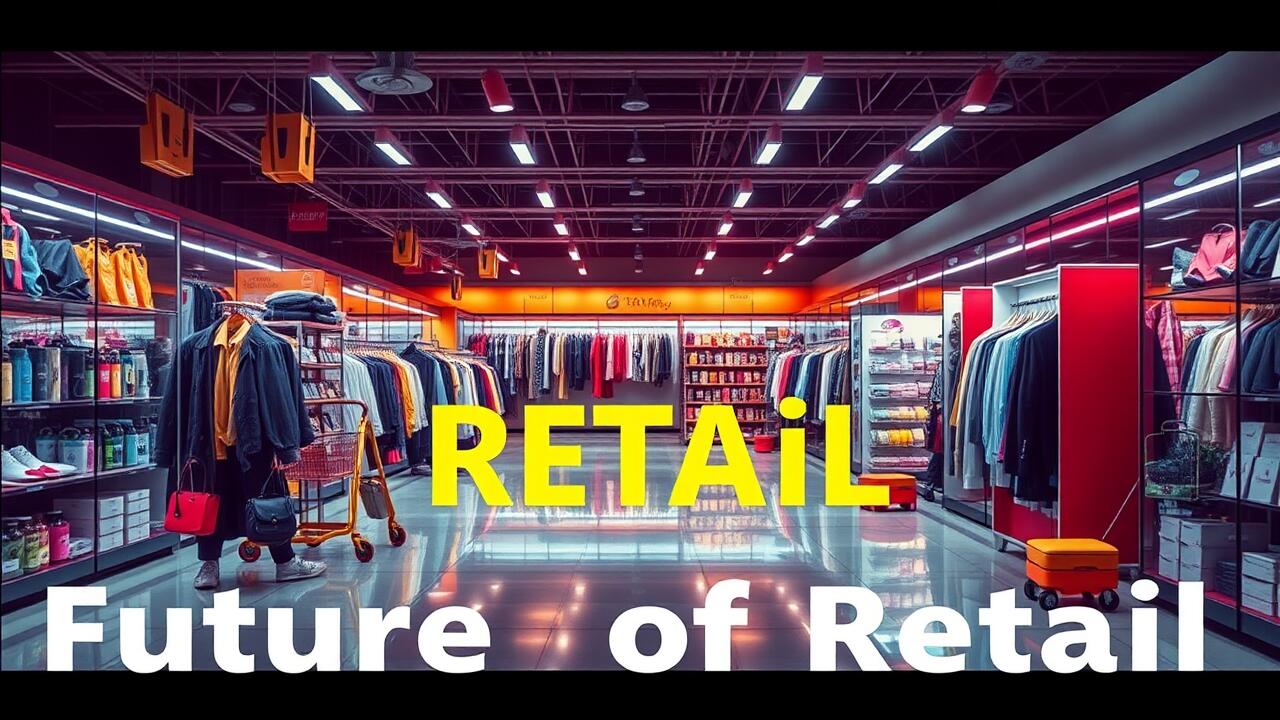Future of Retail Industry
Supply Chain Evolution in Retail
The retail sector is spiraling through a whirlwind of transformation in its supply chain operations, all spurred on by dizzying technological leaps and the insatiable demands of consumers. More and more companies are diving headfirst into the world of data analytics and automation, striving to fine-tune their inventory management while ramping up logistics efficiency to new heights. These cutting-edge innovations allow for real-time product tracking—like a hawk eyeing its prey—enabling retailers to pivot swiftly in response to market fluctuations while also embedding sustainability deep within their operational DNA.
Ah, sustainability! It has risen like a phoenix as a pivotal focus within the intricate web of supply chains. Retailers are now prioritizing eco-conscious practices: responsibly sourcing materials here, deploying energy-efficient transportation methods there. This seismic shift not only caters to an ever-growing consumer clamor for transparency and ethical conduct but also bolsters brand reputation amidst fierce competition. Consequently, businesses are reimagining their entire supply chain playbooks, adjusting strategies with agility to keep pace with evolving consumer preferences and tightening regulatory frameworks that demand accountability at every turn.
Adapting to Demand Fluctuations with Technology
In the ever-evolving landscape of retail, a dynamic shift is underway as retailers increasingly embrace cutting-edge technologies to navigate the unpredictable tides of consumer demands. Picture this: machine learning algorithms and artificial intelligence systems delving into oceans of data, analyzing it in real-time to unravel the intricate tapestry of demand trends and finely tune inventory levels. These revelations empower businesses to foresee shifts in consumer behavior with uncanny precision, enabling them to react swiftly—dodging the pitfalls of overstocking or understocking that have plagued many.
But wait! The narrative thickens with the infusion of IoT devices, which weave yet another layer into this complex web of data collection. Here, smart shelves and interconnected gadgets become vigilant sentinels, monitoring not just inventory but also the subtle nuances of customer interactions. This technological prowess deepens insights into purchasing behaviors, paving the way for hyper-personalized marketing strategies that strike a chord with individual shoppers.
As a result? Businesses don’t merely achieve inventory accuracy; they embark on a journey toward elevating customer satisfaction through targeted promotions and bespoke offerings that resonate harmoniously with real-time demands. It’s an exhilarating dance between technology and human behavior—a thrilling chase where every twist reveals new opportunities for growth!
| Technology | Use Case | Benefits |
|---|---|---|
| Machine Learning | Demand Forecasting | Improved accuracy in predicting consumer behavior |
| IoT Devices | Inventory Management | Real-time monitoring of stock levels |
| Artificial Intelligence | Data Analysis | Uncovering insights for personalized marketing |
| Smart Shelves | Customer Interaction Tracking | Enhanced understanding of purchasing behaviors |
| Predictive Analytics | Promotional Strategies | Targeted offers that resonate with shoppers |
The Importance of Customer Experience
In the bustling arena of retail, customer experience has surfaced as a pivotal game-changer—a crucial differentiator that can tip the scales between success and obscurity. Businesses are waking up to the undeniable truth: crafting a seamless, personalized journey for their customers isn’t just nice to have—it’s essential for nurturing loyalty and driving sales skyward. Entering this new realm, retailers are deploying an arsenal of strategies designed to elevate this experience; think advanced technologies seamlessly woven into operations and insightful customer feedback utilized like gold.
This monumental shift toward a customer-centric paradigm demands that retailers place engagement at the forefront—across every conceivable touchpoint. It’s not merely about in-store interactions or online clicks; no, every morsel of the customer journey requires meticulous optimization. Imagine interactive solutions blossoming before your eyes—augmented reality experiences beckoning customers closer while tailored recommendations whispering sweet nothings about products they never knew they needed! By actively hunting down and weaving in valuable consumer insights, retailers position themselves not only to meet today’s whims but also to predict tomorrow’s trends with uncanny accuracy. This foresight solidifies market standing while nurturing lasting relationships that withstand the test of time.
Enhancing Engagement Through Interactive Solutions
In the ever-evolving realm of retail, interactive solutions have emerged as vital threads in the intricate tapestry that weaves brands and consumers together. Imagine a shopping experience where augmented reality (AR) and virtual reality (VR) converge to create not just transactions but vivid, immersive journeys for customers—engaging them on a sensory playground like never before! These groundbreaking technologies don’t merely enhance how products are seen; they craft personalized adventures tailored to individual whims and desires. As shoppers yearn for distinctive interactions, those brands brave enough to embrace this tech-savvy frontier can stand out from the crowd, forging bonds that nurture unwavering customer loyalty.
But wait—there’s more! Picture gamification elements sprinkled throughout retail spaces like confetti at a celebration. This clever integration of game-like features transforms mundane shopping trips into thrilling quests brimming with exploration and participation. Who doesn’t relish challenges or chase after rewards? Interactive content captivates attention, sparking curiosity that makes consumers linger longer—and come back again! Such strategies don’t just boost foot traffic; they skyrocket conversions too! The takeaway is crystal clear: evolving marketing tactics to weave in these dynamic interactive experiences is no longer optional—it’s essential for meeting the vibrant expectations of today’s savvy shoppers.
Social Media’s Influence on Retail Marketing
The surge of social media has radically reshaped the landscape of retail marketing, don’t you think? It’s a wild ride! Platforms like Instagram, Facebook, and TikTok burst forth with opportunities for brands to connect with vast swathes of audiences through precisely targeted ads and captivating content. Retailers are now tapping into the power of user-generated content and influencer collaborations, crafting visibility that feels real—authentic even—in their interactions with consumers. This direct line of communication doesn’t just build bridges; it weaves a vibrant tapestry of community where insights into consumer preferences flow freely.
But wait—there’s more! The very essence of social media is its interactivity. Retailers can jump on promoting new products at lightning speed, share enticing promotions, and engage in customer inquiries as they happen—all in real time! Think about that immediacy: it’s not just boosting brand engagement; it’s nurturing loyalty among consumers like never before. With the capacity to track metrics and dissect campaigns down to their very core, retailers find themselves on an endless quest for refinement—constantly tweaking strategies to amplify reach amid this ever-shifting digital whirlwind. Isn’t it fascinating how quickly things change?
Building Brand Loyalty Through Digital Platforms
In today’s fast-paced digital landscape, online platforms are not just tools; they’ve morphed into essential lifelines for cultivating unwavering brand loyalty among consumers. Picture this: brands diving headfirst into the vibrant whirlpool of social media and other virtual realms, crafting experiences that feel uniquely tailored to each individual. It’s a dance of targeted promotions and steady communication—this isn’t mere marketing; it’s about making customers feel truly cherished.
And then there are those interactive campaigns, bursting with creativity! They beckon consumers to engage actively, sharing their own tales and weaving a rich tapestry of community around the brand—a camaraderie that transcends mere transactions.
Now let’s talk about user-generated content—it’s like rocket fuel for loyalty initiatives. When customers take the plunge and share their personal stories or rave reviews, it doesn’t just sprinkle authenticity over a brand; it creates ripples that inspire others to join in on the conversation. Enter loyalty programs tailored for our digitally savvy crowd—these aren’t your run-of-the-mill schemes. They offer tantalizing incentives designed specifically for tech enthusiasts, all while meticulously tracking preferences and behaviors. This intelligence enables brands to refine their offerings continuously, keeping them nimble amidst an ever-evolving marketplace where change is the only constant!
Future Retail Spaces and Design
The metamorphosis of retail environments is taking a thrilling turn, increasingly honing in on the intricate tapestry of consumer desires while weaving in state-of-the-art technology. Retailers are delving into innovative concepts like modular layouts that can shift and reshape themselves with the ebb and flow of trends and customer whims. But wait—there’s more! The rise of immersive experiences is reshaping the very fabric of shopping, merging tangible interactions with digital wonders. This dynamic interplay invites consumers to engage with products in ways that feel fresh and exhilarating, ultimately transforming their entire shopping journey.
And let’s not overlook sustainability—a cornerstone for tomorrow’s retail spaces. Brands are embracing eco-conscious materials and energy-savvy systems as they strive to reduce their carbon footprint. By championing sustainable practices, they not only capture the hearts of environmentally aware shoppers but also cultivate an appealing brand persona. Infusing biophilic design elements—think lush greenery intertwined with streams of natural light—creates a serene connection between retail havens and Mother Nature herself, conjuring a soothing vibe that elevates customer satisfaction to new heights!
Creating Experiential Environments for Consumers
Retail spaces are undergoing a fascinating metamorphosis, morphing into vibrant realms that beckon consumers to engage on various levels. Brands are increasingly awakening to the critical need for crafting unforgettable experiences that transcend mere transactions. This transformation is not just about flashy aesthetics; it’s an intricate dance of innovative designs and layouts that spark curiosity and invite interaction at every turn. Imagine weaving in elements of technology—augmented reality here, virtual reality there—turning an ordinary shopping trip into a captivating odyssey that seizes attention and nurtures emotional bonds.
But wait! It’s not just about how things look; these experiential environments also strive to foster a sense of community among shoppers. Picture interactive kiosks, creative workshop zones, and live demos pulling patrons deeper into the brand’s narrative tapestry. This method doesn’t merely boost product visibility—it builds enduring loyalty as consumers begin to resonate with the core values and unique offerings of the brand itself. By elevating these immersive experiences to the forefront, retailers can carve out their niche in a crowded marketplace while deftly adapting to evolving consumer desires and expectations.
- Create multi-sensory experiences that appeal to sight, sound, touch, and smell.
- Incorporate technology-driven tools to enhance interactivity, such as QR codes and touchscreens.
- Design flexible spaces that can easily adapt to seasonal themes or changing consumer trends.
- Host events or workshops that encourage community engagement and brand interaction.
- Showcase customer-generated content to build authenticity and strengthen brand connections.
- Prioritize sustainability in design and product offerings to align with consumers’ values.
- Leverage data analytics to tailor experiences that meet specific customer preferences and behaviors.
Globalization and Its Effects on Retail
The retail landscape is in a whirlwind of change, propelled by the relentless tide of globalization—a force that opens up a kaleidoscope of markets and consumer demographics. No longer shackled to local confines, businesses can now stretch their ambitions across borders, diving into the rich diversity of global tastes and preferences. This paradigm shift isn’t just an expansion; it’s a treasure trove for brands eager to craft unique offerings tailored precisely to the whims and fancies of local consumers. Imagine retailers fine-tuning their supply chains, plucking materials from far-flung corners of the world—an intricate dance that leads not only to cost savings but also broadens access to essential raw materials.
Yet, with this vast expanse comes a labyrinthine set of challenges that demand nimble navigation infused with cultural awareness and adaptability. To truly connect with audiences on foreign shores, understanding local customs and consumer behaviors becomes paramount; otherwise, marketing efforts can miss the mark spectacularly. A generic approach? That could spell disaster! It risks driving potential customers away rather than inviting them in for engagement. On top of it all loom geopolitical tensions and trade regulations—wild cards that can throw even seasoned global retailers off balance. Thus, agility is key: balancing overarching strategies that span continents while executing finely tuned tactics rooted in local contexts is crucial for thriving amid these complexities.
Navigating Cultural Sensitivities in International Markets
Navigating the intricate tapestry of cultural nuances is absolutely vital for retailers eyeing expansion into international realms. A slip in understanding can spiral into marketing disasters, potentially estranging valuable customers. Thus, companies must dive deep—extensive research into local customs, values, and consumer behaviors isn’t just beneficial; it’s essential. This reservoir of knowledge empowers businesses to craft offerings and communications that truly resonate with their intended audience.
But wait—it’s not just about words! Sensitivity to cultural variations seeps right into the products themselves. Retailers ought to grapple with language disparities alongside symbolism, color interpretations, and the rich fabric of holiday traditions. What might soar as a triumphant marketing campaign in one locale could crash spectacularly or even offend elsewhere if shrouded in ignorance. By forging alliances with local connoisseurs who possess an intimate grasp of these nuanced practices—and by staying attuned to community needs—retailers can sculpt an inclusive shopping experience that cultivates brand loyalty while amplifying their global footprint.
Conclusion
The retail industry is undergoing a seismic shift, propelled by rapid technological leaps and the ever-changing desires of consumers. Companies daring enough to embrace this wave of innovation will not only untangle the intricate web of modern commerce but also seize golden opportunities that sprout from fluctuating market trends. As businesses pour resources into revamping their supply chains, enhancing customer engagement, and crafting unforgettable shopping experiences, they set themselves up for enduring success amid fierce competition.
Peering into the horizon, we see a fascinating dance between globalization and tech integration poised to mold the future landscape of retail. By tapping into cultural nuances and harnessing digital platforms, brands stand ready to cultivate profound connections with shoppers across the globe. This emerging terrain hints at a radical reimagining of traditional retail norms—ushering in an era marked by greater interconnectivity, responsiveness, and personalized shopping adventures tailored to meet the diverse needs of varied markets.







